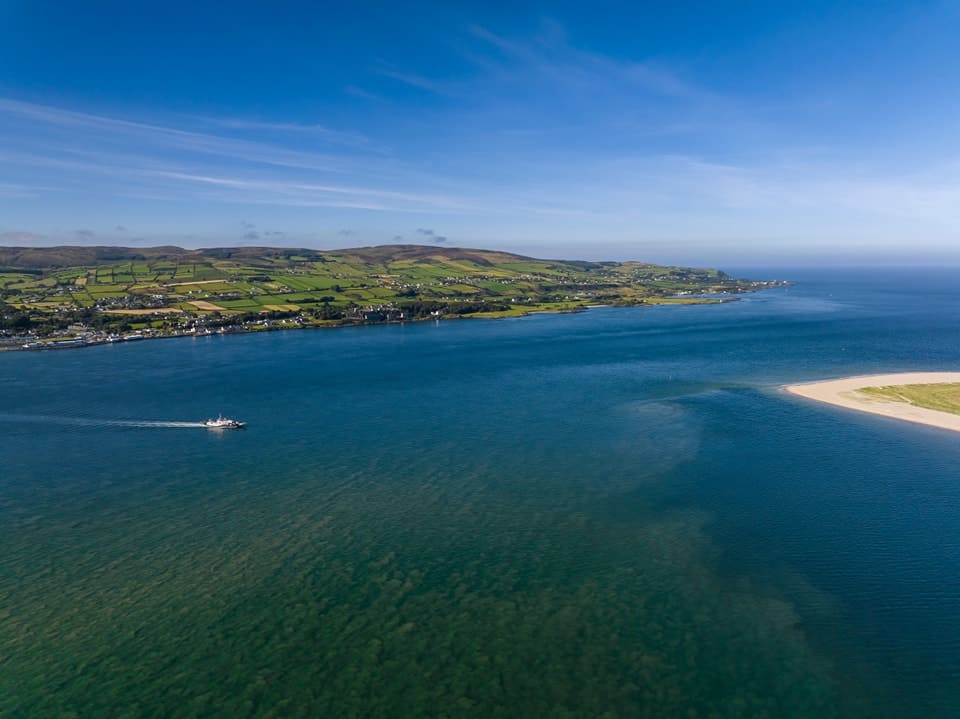Magilligan is an area of historical and environmental importance. The Martello Tower at Magilligan Point illustrates the small defensive forts constructed as a precaution against potential attacks from Napoleon’s forces in the 19th Century. Magilligan Beach is a highly researched coastal landform in the region. Car park options are available for visitors at Magilligan Point, including locations near the Ferry Terminal and Martello Tower.
Magilligan Point is a peninsula located at the western tip of the Causeway Coastal Route of . From this point, excellent views overlook the River Foyle towards Donegal.
Magilligan Beach is a golden sandy beach stretching seven unbroken miles from Point Road and the Magilligan Martello tower and passing through Benone Strand to Downhill Beach. Parking and Toilets are available, and dogs on leads are allowed. Note pedestrian access to the beach is limited to foot traffic only.
Magilligan To Greencastle Ferry terminal
Lough Foyle Ferry is delightful ferry ride offers passengers a unique vantage point of the stunning landscapes, with the rolling hills of Donegal to one side and the rugged beauty of the Causeway Coast on the other. As you glide across the tranquil waters of Lough Foyle, the short voyage is not just a means of travel but an enchanting experience that stitches the scenic tapestry of Ireland’s north together..
The Lough Foyle Ferry Company, established in 2002, provides ferry services from Magilligan Point, County to the Inishowen Peninsula of County Donegal at Greencastle. The tickets are affordably priced, the ferry departs every hour, and it is an enjoyable experience for the entire family, with Donegal being a wonderful destination.
The Lough Foyle Ferry website provides ferry post sailing times for a peaceful and scenic 15 minute ride across the mouth of the Foyle. There is a car park opposite the Ferry Terminal at Magilligan, providing convenient access to the beach and nearby attractions like the Martello Tower.
Magilligan Point Martello tower
Perched commandingly on the edge of Magilligan Point, the historic Martello Tower stands as a sentinel over the strategic stretch of the Northern Irish coastline. This stout, round structure, with its thick walls and robust design, is a classic example of 19th-century military architecture, built in 1812 together with another at Greencastle on the Donegal coast opposite, to thwart Napoleon’s forces during the Napoleonic Wars, commanded the strategically important entrance to Lough Foyle.
The circular tower is built of dressed stone, 10m high, 12m in diameter, tapering slightly upwards. The entrance at first floor level was by retractable ladder and the five-corbelled machicolation above gave added protection. The ground floor was a powder and ammunition store with a water cistern, the first was residential, and on the top was a 24-pounder cannon on a central pivot and circular rail.
A fireplace in the thickness of the wall top allowed the defenders to heat their ammunition – lethal against timber ships. There is a car park adjacent to the Martello Tower, making it easily accessible for visitors.
Today, Magilligan is a fascinating historical monument, offering visitors a tangible connection to the past and an opportunity to explore a piece of military heritage that has withstood the test of time and elements, all while providing panoramic views of the surrounding seascape. Upon arrival, visitors can see the Martello Tower straight ahead after passing through a kissing gate.
Magilligan Nature Reserve
Magilligan Nature Reserve is recognised as a Special Area of Conservation (SAC) and an Area of Special Scientific Interest (ASSI). The Magilligan Foreland stretches for 20 miles and is known as Ireland’s Largest Coastal Accumulation.
The Sand dunes at Magilligan point are considered prime examples of planetary ‘Air Bending’ and should be treated with respect. A route description of Magilligan Point includes a walking path through the National Nature Reserve, highlighting scenic views and historical sites such as the Martello Tower and Lough Foyle Ferry. According to The Department of the Environment, no other site in Northern Ireland has such a significant number of dune grassland and dune slack plant communities.
Sand dunes are a natural part of the landscape that undergo changes due to the movement of sand by ocean currents and wind. A short beach walk at Magilligan Point allows visitors to explore the National Nature Reserve, enjoying the natural beauty and wildlife, including birdlife and sealife, while highlighting key points of interest like the nearby Martello Tower. When the sand dries out, it can be blown inland and get caught by plants, leading to the formation of a sand dune system.
Lough Foyle

Magilligan to Greencastle Lough Foyle Ferry Crossing – Photo By @loughfoyleferry
Lough Foyle is designated as an Area of Special Scientific Interest (ASSI) and is also recognized as a Ramsar Site based on 3 criteria.
The wetland complex has a significant role in the hydrological, biological, and ecological system of a major river basin situated in a trans-border position.
The Lough Foyle estuary and its tributary rivers support rare, vulnerable, or endangered plant and animal species. The estuary and lower reaches of some rivers have notable fish species, including Allis shad, Twait shad, smelt, and sea lamprey, which are listed in the Irish Red Data Book. The system is important for the migration of Atlantic salmon to and from their spawning grounds.
The area supports a diverse range of wintering waterfowl, including significant populations of Whooper swans, Light-bellied Brent geese, and bar-tailed godwits. The Point Bar leading to nearby attractions such as the Martello Tower and Lough Foyle serves as a key landmark for navigation. It is also home to several wildfowl species that are nationally important in an all-Ireland context, such as red-throated divers, great crested grebes, mute swans, Bewick’s swans, greylag geese, shelducks, common teals, mallards, Eurasian wigeons, common eiders, and red-breasted mergansers. Additionally, it plays a crucial role in supporting nationally important wader species, including Eurasian oystercatchers, Eurasian golden plovers, grey plovers, lapwings, red knots, dunlins, Eurasian curlews, common redshanks, and greenshanks.
Ramsar is recognised for its efforts in conserving and responsibly utilising wetlands.
The Ramsar Convention is an intergovernmental treaty that aims to promote the conservation and wise use of wetlands and their resources through national and international cooperation.
Map to Magilligan:
Please tap the markers for information or use pinch and zoom to navigate the map.
You can open it using the Google Maps app.

About the author
